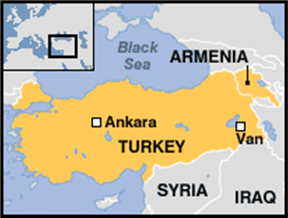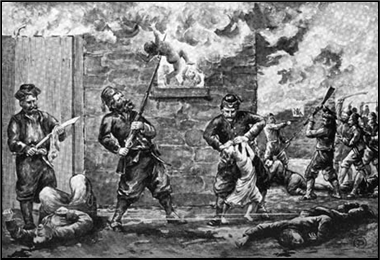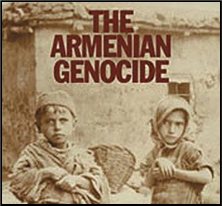


xxxxxToday the Ottoman Emperor Abdul Hamid II, who reigned from 1876-
Acknowledgements
Map (Armenia): from kurdisharmenian.blogspot.com Abdul Hamid: “The Butcher”, from a contemporary French political cartoon, artist unknown. Massacre: a sketch by an unknown eyewitness, contained in Turkey and the Armenian Atrocities by the Rev. Edwin Munsell Bliss (1848-
xxxxxSultanxAbdul Hamid II, the Ottoman Emperor who monopolised power and ruthlessly crushed any opposition to his reign from 1876 to 1909, is particularly remembered today for the Armenian Massacres, the brutal repression of a Christian people during a campaign of ethnic cleansing from 1894 to 1896. It is estimated that between 80,000 and 300,000 were killed, and over 50,000 children were made orphans. And in addition to the destruction of some 2,500 villages, more than 600 churches and monasteries were desecrated across the empire.

 xxxxxBy the late 1880s some 2.5 million Christian Armenians were living within the Ottoman Empire. In the East a movement amongst them demanding equal rights and some form of territorial autonomy was followed by civic unrest at Marsovan in 1892 and at Tokat the following year, towns in the central Black Sea region of Anatolia. This alarmed Abdul Hamid. He perceived this as a direct threat to the Islamic character of the state, and the internal security of the Ottoman Empire, already fighting a desperate battle for survival. When, in 1894, an Armenian protest against heavy taxes and constant persecution by the local Kurds was reported in the region of Sasun -
xxxxxBy the late 1880s some 2.5 million Christian Armenians were living within the Ottoman Empire. In the East a movement amongst them demanding equal rights and some form of territorial autonomy was followed by civic unrest at Marsovan in 1892 and at Tokat the following year, towns in the central Black Sea region of Anatolia. This alarmed Abdul Hamid. He perceived this as a direct threat to the Islamic character of the state, and the internal security of the Ottoman Empire, already fighting a desperate battle for survival. When, in 1894, an Armenian protest against heavy taxes and constant persecution by the local Kurds was reported in the region of Sasun -
 xxxxxThere followed a deliberate and systematic destruction of a defenceless minority in towns and villages across the empire. Thousands of Armenians fled the country -
xxxxxThere followed a deliberate and systematic destruction of a defenceless minority in towns and villages across the empire. Thousands of Armenians fled the country -
xxxxxNews of the atrocities was quickly conveyed around the world and caused moral outrage in Europe and the United States. Abdul Hamid was vilified -
 xxxxxBut, unbelievable as it seems, worse was to come. The rule of the Young Turks which followed the fall of Abdul Hamid II in 1909 did not bring the promise of a liberal, constitutional government. Far from it. The country was very soon under a ruthless dictatorship, and one which aimed to conduct a Holy War against the enemies of Islam. Following the outbreak of the First World War in 1914, on the pretext that the Armenians posed a danger to the state, it embarked on a plan to exterminate this Christian minority. The men were systematically shot or stabbed to death, and the women and children subjected to an appalling catalogue of torture, rape and killing, including roasting alive and crucifixion. Those who survived were then deported, many dying (and planned to die) on the long forced-
xxxxxBut, unbelievable as it seems, worse was to come. The rule of the Young Turks which followed the fall of Abdul Hamid II in 1909 did not bring the promise of a liberal, constitutional government. Far from it. The country was very soon under a ruthless dictatorship, and one which aimed to conduct a Holy War against the enemies of Islam. Following the outbreak of the First World War in 1914, on the pretext that the Armenians posed a danger to the state, it embarked on a plan to exterminate this Christian minority. The men were systematically shot or stabbed to death, and the women and children subjected to an appalling catalogue of torture, rape and killing, including roasting alive and crucifixion. Those who survived were then deported, many dying (and planned to die) on the long forced-
xxxxxDuring the war Turkey’s enemies, Britain and France, were in no position to take action, and Germany and Austria-
xxxxxIncidentally, the atrocities committed by Abdul Hamid II in the years 1894 to 1896 are often called the ”Hamidian Massacres” to differentiate them from the “Armenian Massacres” carried out during the First World War. ……
xxxxx…… Later, as we shall see, Abdul Hamid II was involved in the Greco-
Vc-


